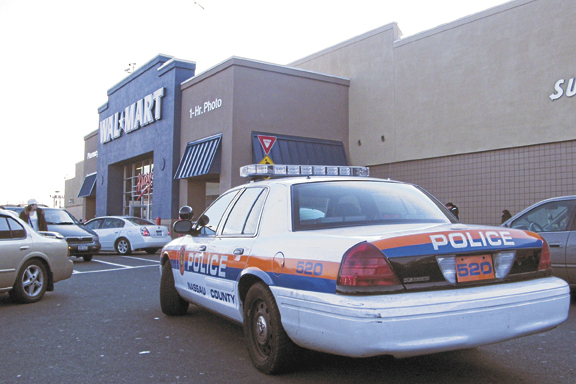Lessons learned from Walmart trampling
Retailers emphasize worker, shopper safety three years after trampling
The trampling death of a Valley Stream Walmart employee in November 2008 garnered national attention and prompted action by the U.S. Department of Labor’s Occupational Safety and Health Administration.
OSHA ordered Walmart to pay a $7,000 fine as a result of the Black Friday tragedy, in which 34-year-old temporary employee Jdimytai Damour died of asphyxiation when a crowd of some 2,000 shoppers stormed into the store, trampling him, when the store opened at 5 a.m. the day after Thanksgiving. Walmart appealed the fine last year, and that litigation remains unsettled. But in the months after the incident, Walmart reached a settlement with Nassau County District Attorney Kathleen Rice and avoided criminal charges.
In the months following Damour’s death, local members of the New York Committee for Occupational Safety and Health and the WorkPlace Project, a workers’ rights organization, demonstrated outside the Green Acres Mall in an effort to promote employee safety. “It was unfortunate and upsetting,” Monica Diaz, a workers’ rights advocate with the WorkPlace Project, said recently.
Three years later, several retailers say they are focused on employee and customer safety. Retail giants have started implementing detailed policies for crowd management for Black Friday sales and the remainder of the holiday season. Store officials say they have learned from the tragedy and want to prevent anything like it from happening again.
A time for change
“OSHA has picked this up and identified it as a major issue to be dealt with about employees,” said Joel Shufro, acting director of the New York Committee for Occupational Safety and Health. The Walmart death was a seminal case that brought attention to workplace hazards and changed holiday-season operations in several ways, he added.
“It alerted various retail companies to be alert to hazards and take action against repeating this event,” Shufro said. “People think in advance of how to deal with crowd control, and are making sure employees are more protected.”
Walmart has taken several steps to improve employee safety in the three years since the incident. Company representatives worked with nationally recognized crowd-management experts to create and implement what they describe as a successful, comprehensive and first-of-its-kind nationwide plan. It incorporates proven crowd-management techniques into the unique characteristics of a retail setting, Greg Rossiter, the company’s director of corporate communications, explained.
The plans vary by store, Rossiter said, but Walmart officials now monitor customer flow in three key areas — approach and entry, flow around merchandise, and movement in checkout aisles and away from the store. The plan worked well during last year’s holiday season, Rossiter added, and Walmart is confident that customers will have a safe shopping experience this year.
“We never had a tragedy like that in our stores, and we never want it to happen again,” Rossiter said. “We are committed to learning from the incident and have made our stores safer.”
Stores should have trained security or police officers and barricades or rope lines for customers, as stated in a fact sheet released by OSHA last year titled “Crowd Management Safety Tips for Retailers.” It recommends that once a store reaches maximum occupancy, no more customers should be allowed in until others leave. And no exit doors should be blocked or locked. “Crowd control is critical to preventing injuries and deaths,” said OSHA Assistant Secretary Dr. David Michaels.
Planning to keep history from repeating
Other retailers are acting to ensure a safe environment as well. At Target, store officials will monitor parking lot sections and employees will be more visible during holiday sales events, company spokesman Antoine LaFromboise said. There will also be maps posted and given out at Target stores, he said, which will clearly mark areas for customers to line up for checkout. The chain will add more crowd-management training for store team leaders, LaFromboise said, guide customers into the stores in small groups and create a 10-foot buffer zone between store entrances and the customers lined up outside.
LaFromboise added that the company examined other retailers’ crowd-management policies from past years and considered the success of those and other factors as a basis for developing its policies.
Customer and employee safety and security are the highest priorities at Toys “R” Us, according to spokeswoman Katelyn Leondi. The chain’s policies includes overseeing checkout lines, maintaining constant communication with crowds, and expanding hours when heavy customer volume is expected, she said. The company also continues to evaluate the retail industry’s best practices in order to raise the bar when it comes to crowd control, Leondi added.
Rossiter said that Walmart stores, which will be open around the clock on Thanksgiving and Black Friday, have established a Facebook page at which customers can get information. “We have the stores located nearest them, hours, sales events, store maps,” he said, “and it will show where the promotional items are around each store.”
Shufro said that experience has shown that companies will listen to the government if heavy fines are levied when a retailer fails to make employee and shopper safety a priority.
The New York Committee for Occupational Safety and Health trains workers in how to be safe and healthy and protect themselves at the workplace, Shufro said. “It has not changed our practice,” he said, referring to the Walmart tragedy, “but called attention to this problem.”

 47.0°,
Mostly Cloudy
47.0°,
Mostly Cloudy 




